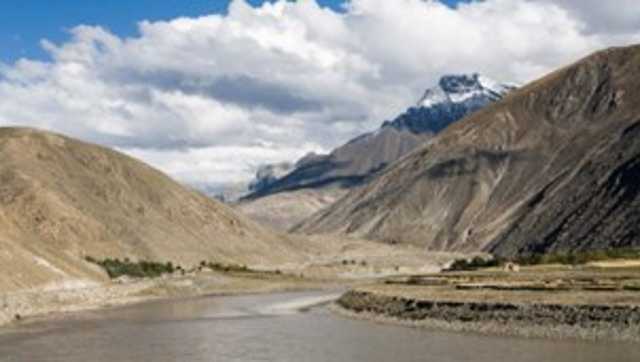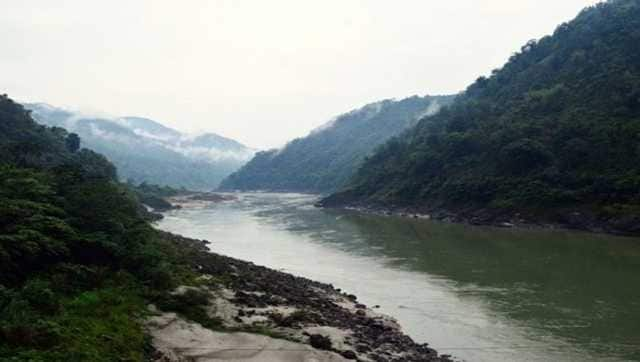Brahmaputra, the youngest among major rivers in the world, is the lifeline of Assam as well the North East. Innumerable folktales and songs depict the love and emotions the people of the region have for the river since ages. During Ashokasthami, people in the state believe it becomes holier than Ganges. [caption id=“attachment_10898831” align=“alignnone” width=“640”]
 Tsanpo River, Tibetan Autonomous Region of China[/caption] Since 1954 the state has withstood 13 devastating floods; on an average Assam receives three to four waves of flood every year between May to September. These floods occur due to overflow from downpour and high sediment of landslides. Deforestation and shifting cultivation adds to the woes. The flood discharge of the Brahmaputra river is the fourth-highest in the world. As for annual sediment transport, it reaches 500 million tons, and is the second-highest, next to the Yellow river in the People’s Republic of China. [caption id=“attachment_10898841” align=“alignnone” width=“640”]
Tsanpo River, Tibetan Autonomous Region of China[/caption] Since 1954 the state has withstood 13 devastating floods; on an average Assam receives three to four waves of flood every year between May to September. These floods occur due to overflow from downpour and high sediment of landslides. Deforestation and shifting cultivation adds to the woes. The flood discharge of the Brahmaputra river is the fourth-highest in the world. As for annual sediment transport, it reaches 500 million tons, and is the second-highest, next to the Yellow river in the People’s Republic of China. [caption id=“attachment_10898841” align=“alignnone” width=“640”]
 Siang River, Arunachal Pradesh[/caption] The Indian subcontinent has seen people being displaced, becoming refugees because of Partition, but in Assam there are many who shall share their stories of being displaced by the mighty river because of its erosion. By now people have learnt to live with their plight, to be victims of flood. This year Assam has witnessed unprecedented floods, almost all 33 districts are affected by flood. State authorities have set up 366 relief camps across 20 districts, providing temporary shelter for more than 95,000 people. Roads, homes and buildings have been submerged by flood waters in most parts of the state. [caption id=“attachment_10898851” align=“alignnone” width=“640”]
Siang River, Arunachal Pradesh[/caption] The Indian subcontinent has seen people being displaced, becoming refugees because of Partition, but in Assam there are many who shall share their stories of being displaced by the mighty river because of its erosion. By now people have learnt to live with their plight, to be victims of flood. This year Assam has witnessed unprecedented floods, almost all 33 districts are affected by flood. State authorities have set up 366 relief camps across 20 districts, providing temporary shelter for more than 95,000 people. Roads, homes and buildings have been submerged by flood waters in most parts of the state. [caption id=“attachment_10898851” align=“alignnone” width=“640”]
 Devastating Assam floods[/caption] Interestingly, traditional flood impacted districts — Dhemaji, North Lakhimpur, Sivsagar and Majuli — are comparatively less affected by the first wave of flood. In contrast, lower and middle Assam districts like Bongaigaon, Barpeta, Nalbari, Mangaldai and Sonitpur are worst affected this year. Although the state has received 62 per cent more than usual rainfall during March-May this year, the primary reason in these districts is the excessive water released by bordering Bhutan from its dam.
Devastating Assam floods[/caption] Interestingly, traditional flood impacted districts — Dhemaji, North Lakhimpur, Sivsagar and Majuli — are comparatively less affected by the first wave of flood. In contrast, lower and middle Assam districts like Bongaigaon, Barpeta, Nalbari, Mangaldai and Sonitpur are worst affected this year. Although the state has received 62 per cent more than usual rainfall during March-May this year, the primary reason in these districts is the excessive water released by bordering Bhutan from its dam.
***
Also Read Firstpost Podcast: Why Assam is prone to floods Explained: The Assam floods and the unfolding of a food and water crisis Explained: How Assam floods have endangered animals at Kaziranga National Park
***
Although the state government has decided to dredge the river for erosion control, and flood control, there is no unanimity. According to the experts, dredged material can be utilised to fill geo tubes and to strengthen the existing embankments to Super Levee as developed in Japan. Interestingly, dredging of the Brahmaputra river was suggested way back in the 1950s and the 1960s by several experts, and accordingly, the then government decided to do so in 1966. In 1974, the first attempt was made at Chimna in Kamrup district, when a 7-km stretch was dredged with a width of 30m. Thereafter, a second attempt was made at Alikash to reduce erosion; although dredging prevented bank erosion, it failed to serve for long because the dredged portions were immediately filled up with silts. So far no scientific viability assessment has been conducted in the recent past. However, in far America, dredging of the Mississippi river has proved to be a success story of river basin management. The Americans have dredged the Mississippi river many times. The Mississippi river basin is now controlled and regulated by dams and other river engineering structures. Mississippi has witnessed many devastating floods, the worst being that of 1927.
)